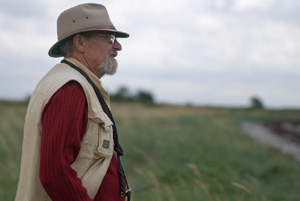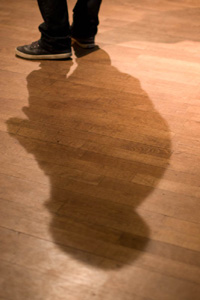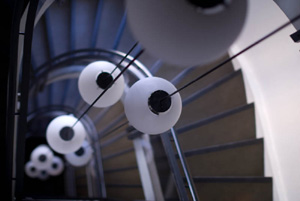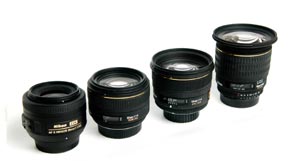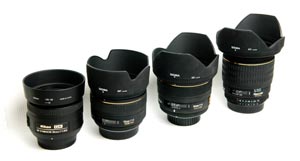Published October 6th 2011
Sigma 50mm f/1.4
I have a weakness for bright lenses and always had great experiences with Sigma. So when I wanted a bright 50mm, I found it natural to look closer at Sigma's offering.
I have had many Sigma lenses in my long photo career. The first really good Sigma lens I used extensively was the midrange 24-70mm f/2.8 zoom that I bought for my Minolta Dynax/Maxxum 7 film camera. This was an outstanding lens, fully comparable to what Minolta and the other brand name companies offered, and I was very happy with it.
When I changed to digital in 2005, it moved with me and served me well in spite of being not quite as wide as I like. Since then I have bought and used several Sigma lenses.
Large range
Sigma offers a really large range of lenses and has some models, which are not common in most camera manufacturer's lineups. Take for instance four different fisheyes ranging from 4.5 to 15mm, the 30mm f/1.4, the 20mm, 24mm and 28mm all f/1.8 or the 10-20mm f/3.5 DX zoom. Add to that a whole army of more common focal lengths such as 24-70mm f/2.8, 70-200mm f/2.8, several macros, long and bright telephoto lenses and classics such as the Bigma (50-500mm f/5.6) not to mention the extremes like the 300-800mm f/5.6 (only 1,100 USD) or the utterly extreme 200-500 f/2.8 at a staggering 3,800 USD.No, in my eyes Sigma have always been nicely different and slightly to the odd side, which I consider absolutely positive!
Normal
The 50mm is still often referred to as a “normal” lens although it performs more like a short portrait telephoto lens on a DX-camera.I acquired the Sigma rather than the Nikon AF-D f/1.4 mostly out of curiosity, but also because I heard and read good things about the Sigma, and because I wanted a lens with built in focus motor. The Nikon—however great it was—was an older construction with screwdriver focus. Since I bought my Sigma, Nikon has marketed a new bright 50mm called AF-S Nikkor 50mm f/1.4G with focus motor and obviously great optical quality. I have no reason to “upgrade” because I think the Sigma is every bit as good as the new Nikon.
Large, heavy, expensive
The Sigma does have some drawbacks.It's about the most expensive 50mm you can buy. Sigma's web site says 730 USD suggested retail! But in real life it retails for about 500 USD, which still makes it some 100 dollars more expensive than the new Nikon AF-S offering, and way more expensive than the old D-model, which can be had for about 300 USD.
Compared to Canon (360 USD), Pentax (360.-) and Sony (370.-) the Sigma is hilariously expensive, and if you consider Sigma a second choice “bamboo” brand, it really makes very little sense.
It's also humongous, in particular compared to its Nikon, Pentax and Sony brethren, which are normal size normal lenses, compact, fairly light and with filter diameters in the 49-52 mm range. Only the Canon is slightly larger than these, but still makes it with a 58mm filter. Going to the notoriously big Canon 50mm f/1.2 you'd need a 72mm filter, which is large for a 50mm lens.
The Sigma requires a 77mm filter!
I actually consider that an advantage, since I have no small filters. All my stable lenses are 77mm filter diameter, and my filter selection is limited to the large disks.
Last but not least it weighs in at 1.1 lbs or 505 grams.
Add to that a large petal-shaped hood. Unfortunately a rather flimsy one. I would expect something much more impressing with a 730 dollar lens! Look at Nikon's hoods for the 17-55mm, 24-70mm and the 70-200mm and learn, Sigma!
But the 50mm f/1.4 is still a lot of lens no matter what.
Handling
I'm actually a sucker for large lenses (compensating for something, Martin?), and its size never really bothered me. I like the look and feel of a good piece of glass, and the Sigma gives full value on all fronts.It feels and handles very nicely. It has the built-in focus motor, which is fast and silent. Fully comparable to what any of my Nikons offer and able to focus in very low light thanks to its brightness.
It has manual override like the new Nikon lenses, so you can grab the focus ring and focus manually any time you want. You can permanently disable the AF on a small switch on the lens if you want.
It's a G-lens and offers distance information to any camera that can use it, and should you be a full frame person, then fret not. The Sigma covers 24*36mm easily.
Image quality
The IQ of the Sigma is to die for! It's as sharp as lenses come. It's bokeh is soft and creamy and it excels wide open, which is how I use it 80% of the time. I certainly like a sharp picture, but in the case of the Sigma I tend to use—maybe even overuse—its paper thin depth of field and soft bokeh. I can't get enough of that.I see some people complaining about edge sharpness especially compared to the new Nikon 1.4, but I honestly consider that a very academic discussion and not a problem at all. 95% of my 50mm images don't have anything in the edge that needs to be sharp. And even full open, the things that are sharp are extremely sharp. The rest is soft as butter, just like I want it.
I'm sure I would be as happy with the new Nikon f/1.4, but I made my choice before it was available, and as I said: I have no urge to change.
Focal length
My only problem with the Sigma is the focal length. 50mm on a DX lens equals a 75mm on a full frame camera, and that is a bit on the long side for a standard lens. I consider my Sigma 50mm more as an “85mm f/1.4 for DX”—a short telephoto lens, well suited for portraits and with all the qualities of a bright 85mm on a full frame body.I still miss a real standard lens, and have actually bought a Sigma 30mm f/1.4 on eBay. It has most of the qualities that the 50mm has, but just the shorter focal length, which puts it very close to a standard 50mm when mounted on a DX body. I really like it.
I know I have the excellent 35mm f/1.8, which is lighter and cheaper than the Sigma 30 (although my Sigma's used price make them comparable), but I still wanted to try the brighter Sigma.
I can probably sell any of them for close to what I paid, so I'm not too worried.
My current Sigma lineup now consists of three prime lenses. The leftmost lens here is the charming Nikkor 35mm f/1.8, and then follows Sigma 30mm f/1.4, Sigma 50mm f/1.4 and
Gear mentioned:
